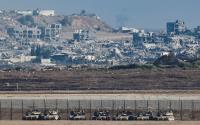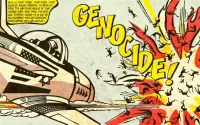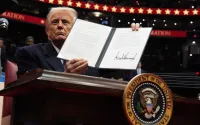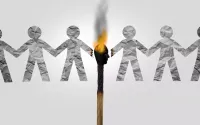22 May 2005
Every waking moment of our lives, we swim in an ocean of advertising, all of it telling us the same thing: consume, consume. And then consume some more. The epidemic of overconsumption begins with the things we put in our mouths. The United States is the fattest nation on earth. Sixty-five per cent of American adults are overweight; 30 per cent are obese. In the decade between 1991 and 2001, obesity figures almost doubled.
But the truly shocking thing is that we've taught our kids how to be fat, too. Obesity rates in American children remained stable throughout the 1960s, but they began to climb in the 1970s. In the past 20 years, the rate of obesity has doubled in children and trebled in teenagers. Kids are starting to clock in as obese as early as the age of two. If we find that surprising, we shouldn't.
During the McMonth I endured for Super Size Me, in which I ate every meal at McDonald's, every day - taking up the option to have a Supersize portion whenever I was offered it - I couldn't get over how many kids there were in the restaurants almost any time that I walked in. Children with their parents. Gaggles of them stopping off for breakfast or for a pre-dinner snack in their cute little school uniforms. Kids in all the play areas. Kids as little as three and four having Happy Meal McBirthday parties. Or, in a McDonald's in Houston, at 9am, a mother with her two very overweight kids who, having just finished their fat-filled breakfasts, were now eating hot fudge sundaes.
Ray Kroc, the man behind the McDonald's empire, understood from Day McOne that youngsters were his target market. He had no sooner bought the company from the McDonald brothers than Ronald McDonald was brought in to attract the kiddies to the burgers and shakes.
The first Ronald was the TV weatherman Willard Scott in his younger, but apparently not leaner, days. Scott had been doing Bozo the Clown on local television. When the show was cancelled, an enterprising McDonald's franchisee asked him to come up with a clown figure that would lure the kids into the restaurant. Kroc saw it, liked it and extended the idea to the whole country.
But first he canned Scott. Kroc understood the negative publicity implications of an icon who looks as though he's been eating too much of the company's food. To this day you'll never see Ronald McDonald eating the food; not in any commercial. He dances and sings, grins and giggles, and smiles at the kids while they stuff their faces, but he never touches the grub. Why? Presumably because, as the late Eazy-E said in the song "The Dopeman": "Don't get high off your own supply."
Kroc also understood the value of promoting McDonald's as a caring, family-friendly sort of place, a place with a heart, not heart disease. Early on, he began linking McDonald's with various children's charities. One executive told John F Love, author of McDonald's: Behind the Arches: "It was an inexpensive, imaginative way of getting your name before the public and building a reputation to offset the image of selling 15-cent hamburgers. It was probably 99 per cent commercial."
Thus the Ronald McDonald House Charities were born. They have now provided housing (and McMeals) for the families of more than two million seriously ill children. Never mind the fact that today an increasing number of children are going into hospital because of eating-related illnesses.
Talking of which, one of the most shocking things I saw during my McMonth was a McDonald's in Texas Children's Hospital - a hospital that is now stapling obese children's stomachs. To me, that seemed utterly irresponsible, a flagrant violation of the doctor's pledge of "Primum non nocere" (First, do no harm). In fact, hospitals across the US have fast-food franchises in them. The top-ranked paediatric hospital in the country, Children's Hospital of Philadelphia, has a McDonald's outlet. Why shouldn't there be one in Houston?
Recently, a combination of good information and bad publicity has encouraged some hospitals to reconsider their food-service contracts. But Ronald won't always leave without a fight. The Cleveland Clinic, for example, wants to rid America's leading heart hospital of its McDonald's. But according to the Cleveland Plain Dealer of 22 November last year, the clinic's chief executive, Dr Toby Cosgrove, received a letter from a McDonald's corporate vice-president called Marty Ranft, which "defended the franchise, and vowed ... that 'McDonald's has no intention of terminating' the remaining 10 years on its lease".
The doctors at Texas Children's Hospital told me they had young patients who were dying of cancer, and it was hard to get them to eat anything. At least these poor kids would eat some fries, take a bite of a burger: food they were familiar with. It was junk that they had been eating all their lives.
But it's not enough to get young people to come to your restaurants; you have to get them to keep on coming back. McDonald's operates something like 8,000 Playlands around America. They're especially attractive to children in neighbourhoods in which playgrounds are scarce. Burger King has about 3,200 of its own. Then there's the Happy Meal, launched in the US in 1979. It cost a buck in those days. Inside a cardboard box with a circus theme, children found a McDoodler stencil, a puzzle book, a McWrist wallet, an ID bracelet and McDonaldland character erasers.
The meal-plus-toys packaging proved to be an instant hit, with the first Star Trek Happy Meals that very year. Soon, toy versions of all your favourite McDonald's mascots were included: Ronald, Grimace, Hamburglar, Mayor McCheese, Big Mac, Birdie and Captain Crook. Later, toys would be themed for tie-ins with brands and films such as Barbie, Hot Wheels, The Little Mermaid, Finding Nemo and so on. By 2003, Happy Meals accounted for about 20 per cent of all meals sold (about $3.5bn in annual revenue).
And let's not forget the Mighty Kids Meal, introduced in America in 2001. McDonald's realised that by the time kids were eight or nine years old they felt they had outgrown the Happy Meal. Those were for little boys and girls. So the Mighty Kids Meal comes in a slightly more "grown-up" package. It offers bigger meals: a double cheeseburger, double hamburger or a six-piece chicken McNuggets, but still comes with a toy. We may be older, but we still like toys.
In 2004, McDonald's celebrated the 25th anniversary of the Happy Meal with a year-long barrage of promotions and advertisements. The company also launched a version for adults, the Go Active! Adult Happy Meal. This included a salad, a bottle of water, a book that told you how to exercise, and an adult "toy": a Stepometer, so you could measure how few steps it was from the counter to your car.
Good old Ronald. Under his smiling, caring guidance, an entire generation of overweight American adults who grew up following him into their local McDonald's are now raising their own overweight children to follow in their heavy footsteps.
Recently, the magazine Advertising Age cited Ronald McDonald as No 2 on its list of top 10 advertising icons of the 20th century. Who was No 1? It was the Marlboro Man.
* * *
Adults bear an enormous responsibility for the obesity epidemic among children. Yet there's also no question that even conscientious parents and guardians, who really do try to do well by kids and teach them healthy life choices, are not playing on anything like a level field. They're going up against billions and billions of dollars spent every year in corporate marketing, all aimed at teaching kids to make exactly the opposite sorts of choices.
McDonald's and the other fast-food chains make no secret of the fact that kids are their primary targets. "We have living proof of the long-lasting quality of early brand loyalties in the cradle-to-grave marketing at McDonald's, and how well it works," James McNeal, a well-known children's marketing guru and the author of Kids As Customers, has said. "We start taking children in for their first and second birthdays, and on and on, and eventually they have a great deal of preference for that brand. Children can carry that with them through a lifetime."
Today, corporations spend more than $15bn every year on marketing, advertising and promotions meant to programme American children to consume, consume and consume some more. Why? Because they realise that children not only have more expendable income of their own, but they influence how their parents spend their hard-earned bucks, too - to the tune of more than $600bn a year. What do children choose to buy with all that cash? What do you think?
Nor is it just their current expenditure that corporations want a slice of: they're looking at the long term. Brand logos for all sorts of crap now turn up on nursery blankets, crib toys and mobiles. In my office, I have a collection of baby bottles shaped like little bottles of 7 Up, Dr Pepper and Pepsi. I found them on eBay. When we contacted the California manufacturer, Munchkin Bottling, they told us they had produced these things for a few years in the mid-1990s. They'd developed the concept themselves, then licensed the various drinks companies' names and logos. Think about the associations formed in infants' minds by these things. Think about the mentality that sees nothing wrong in marketing them.
Not to be outdone, McDonald's marketing genius M Lawrence Light - the guy who rolled out the "I'm lovin' it" campaign - wants to surround the youth of the world with McDonald's brand images. "Light wants to turn everything he can into an ad for McDonald's," wrote Business Week magazine in July 2004. "He's pushing the Oak Brook chain to open clothing shops so kids will walk around in T-shirts with the Golden Arches logo, just as they already do with Old Navy or Disney. He envisions a deal with the National Basketball Association to play the five-note tagline of the 'I'm lovin' it' ad in the stadium every time a player shoots a three-pointer. He's even toying with making the jingle available over the internet so it could be downloaded as a mobile phone ring tone."
Light chose China as the market in which to open the first McKids store. "There will be 25 McKids stores there," he told Business Week. "It's got a line of toys, a line of clothes, a line of videos, all directed at young kids." Why China? Because after years of communist rule, these children can't get enough American products. A company like McDonald's can easily swoop in and corrupt young consumers from the start.
This is adapted from 'Don't Eat This Book', by Morgan Spurlock (Penguin, £7.99). Available from Independent Books Direct on 08700 798 897 (p&p free). An extract also appeared in yesterday's 'Independent'
http://news.independent.co.uk/world/americas/story.jsp?story=640383






